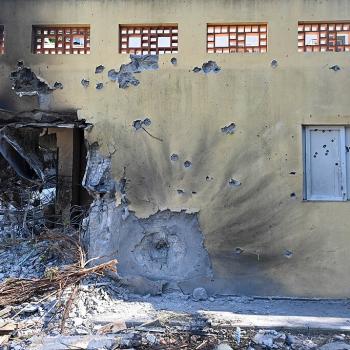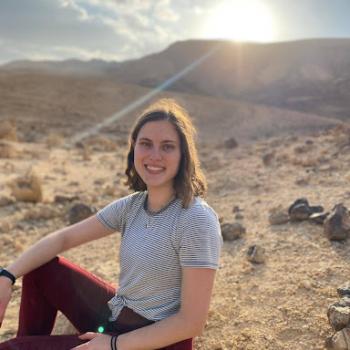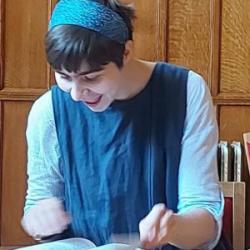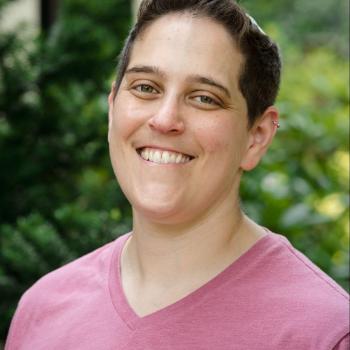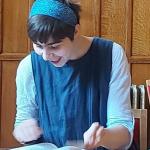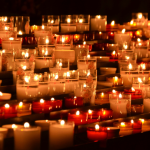 Parshat Beha’alotecha (Numbers 8:1-12:16)
Parshat Beha’alotecha (Numbers 8:1-12:16)
By Rabbi Emma Kippley-Ogman
“Mai shamayim, what are the heavens?” asks the Gemara about the second day of Creation when earth and heavens came to be separate entities (Ta’anit 12a). “An old teaching answers: esh umayim, fire and water. The Holy Blessed One scrambled them together each in the other and made from them the firmament.” אש ומים becomes שמים, the letters themselves combining to make something new out of these essential elements.
We imagine that mixing fire and water should eliminate one of the elements—fire should evaporate water or water should quench fire—but the coexistence of these apparent opposites is essential to Divine creation.
In Parashat Beha’alotecha, we see this astonishing combination established on earth, at the center of the Israelite camp—shamayim in our midst letting us witness and respond to the presence of the Divine (Numbers 9:15-16):
On the day that the Tabernacle was set up, the cloud covered the Tabernacle, the Tent of the Pact; and in the evening it rested over the Tabernacle in the likeness of fire until morning. It would always be so: the cloud covered it, appearing as fire by night.
The cloud is cloud (water vapor) during the day and fire at night, and the daily passage between these two substances cultivates in the desert wanderers an understanding of these opposite elements as essentially one and the same. In a discussion on the timing of lighting Shabbat candles (must it be precisely at sundown, or can it be earlier?), the Talmud (Shabbat 23b) wonders about the daily transitions. Citing Exodus 13:22, “The pillar of cloud by day, and the pillar of fire by night, did not depart from before the people,” Rabbi Yosi concludes that fire and cloud must coexist for a period each day. “The pillar of cloud completes the pillar of fire; and the pillar of fire completes the pillar of cloud.”
To this day, as we light Shabbat candles while light remains in the sky, we embody the moment of transition, the passage from cloud to fire during which these two opposites coexist, neither destroying the other but instead co-creating a spark/fog of Divine presence, shamayim right in front of our faces.
During our wilderness wandering, this cloud/fire cultivated in all of us a very sensitive attention to its presence (Numbers 9:17 & 21-22):
And whenever the cloud lifted from the Tent, the Israelites would set out accordingly; and at the spot where the cloud settled, there the Israelites would make camp. … Day or night, whenever the cloud lifted, they would break camp. Whether it was two days or a month or a year—however long the cloud lingered over the Tabernacle—the Israelites remained encamped and did not set out; only when it lifted did they break camp.
A cloud is there and not there, a space of air with more concentration of water vapor than the air around it. A cloud can be seen, but it is subtle. Easy to miss. You might have to look twice to be sure whether it is there or gone. So the Israelites must have developed a finely calibrated responsiveness to that cloud to be able to notice after it was on the mishkan for a few hours, or a few days, or for years—that it was suddenly gone from that spot, beckoning them yet again to collapse the camp and enter the desert.
The Divine invited the whole people to attune themselves to presence as Moshe had attuned himself How long must he have gazed at the bush in order to realize the flames were not consuming it? Here, the entire people learns a spiritual practice of our teacher—to watch carefully and notice the Divine in subtle shifts in the environment.
In the transition from Egypt, watered by the Nile, to the land of Israel, dependent on rain, learning to give our attention to the cloud was a lifesaving act. Perhaps our ever cloud-watching desert wandering prepared us to notice when the water gates of the heavens would open, giving us existence from the outpouring abundance of rain.
This careful attunement is also the energy that links lover and beloved. Midrash (Yelamdenu 51) uses a parable to read our cloud as a link back to Sinai and a promise of public affection:
The cloud covering the mishkan is the same cloud that revealed itself at Mount Sinai. To what is this similar? To a king who had a lover. He sent a message: “Prepare yourself, for I will come to you on a certain day!” The lover did not believe it. He replied: “Even if he comes to me he will come disguised as an ordinary person or at night.” The king understood what his lover said and sent back: “By your life I will come to you during the day, in public, riding the horse I rode on the day I became king, and wearing the purple cloak that was thrown upon me on the day I became ruler—so that all will know how beloved you are to me.”
The midrash reads God (the king) appeasing the skeptical Israelites (the lover) when they worried that God would not come into the mishkan they had built. God transformed the one-night encounter of Sinai into a love affair that could span space and time by appearing in the cloud on the mishkan—in the same royal cloak that God had donned at Sinai (Exodus 19:9 – I will come to you in a thick cloud). The cloud itself evokes attentive and responsive presence as each lover learns to turn towards the other.
Rabbi Yitzhak Nissenbaum (who was murdered in the Warsaw Ghetto) carefully reads Numbers 9:16 to extend this Divine presence, initiated at Sinai, beyond the wilderness wandering and into our present moment. While many commentators read the verse “It would always be so: the cloud covered it, appearing as fire by night” as referencing God’s continuous presence in the wilderness, Rabbi Nissenbaum is quoted saying:
The Holy Blessed One promised us that this is how it would be also in the future, if there would come times “when the cloud covers it,” that black clouds cover the skies and no spark of hope can be seen, with no chance of exit from the terrible situation, we will not despair, rather it is promised that even then “the appearance of fire by night” — from the cloud and the darkness of night a sliver of light will burst forth, the clouds will part and salvation will come.
As we watch carefully for the cloud, may we also witness slivers of light, and by their shining, know love.
Rabbi Emma Kippley-Ogman is a 2010 graduate of the Rabbinical School of Hebrew College and serves as Rabbi and Associate Chaplain for Jewish Life at Macalester College in St. Paul, MN.
Interested in a possible career in the rabbinate? Read Rabbi Dan Judson’s article “Jewish Lessons on Meaningful Work.“ Rabbi Judson is Dean of the Rabbinical School of Hebrew College. He has a PhD in Jewish history from Brandeis University.





